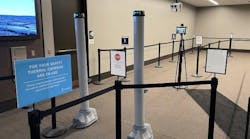WASHINGTON (AP) - The Environmental Protection Agency issued new voluntary guidelines Thursday that rely on industry to secure drinking water and wastewater treatment plants against attack.
The guidelines for improving designs and operations were written by industry groups with EPA financing. The guidance urges improved water security designs and operations, and greater use of online monitoring to protect against the potential misuse of contaminants.
Benjamin Grumbles, the agency's top official for water issues, said ``Americans should feel confident, when they turn on the tap, they have access to some of the cleanest, safest water in the world.''
Pat Natale, executive director of the American Society of Civil Engineers, said water security must be among the country's highest priorities.
The EPA announced the guidelines along with the engineers' group, the American Water Works Association, for drinking water utilities, and the Water Environment Federation, for wastewater professionals.
``Why voluntary, you might ask? Well, frankly there are over 186,000 water infrastructure systems in the U.S. alone,'' Natale said. ``They differ significantly in their size, their structure and their operations. Each utility must individually assess its own system for potential vulnerability. ... It is truly not a one size fits all solution.''
But Erik Olson, a lawyer at the environmental group Natural Resources Defense Council, said industry had strongly objected to giving EPA more authority on water security.
``There's still no authority for federal officials to order a crackdown on security threats at drinking water and sewage plants,'' Olson said. ``We're very concerned the security of the nation's water supplies is turned over to industry with minimal federal oversight.''
The guidelines offer suggestions for thwarting attacks by improving the design, operation and physical security of drinking water and sewage treatment facilities.
That includes tips for designing an online system for detecting contaminants, where to put instruments and sensors and how to respond to suspicious incidents.
Other topics include risk assessment, threat analysis, financial and communications planning, human resources management, operating maintenance and emergency response strategy.
Jeanette Brown, who led an industry task force that developed the guidelines, said another danger from underground wastewater and storm water facilities is their possible use as ``conduits for covert attacks on other infrastructure or sensitive locations at other buildings.''
Brown is a water pollution official in Stamford, Conn.

